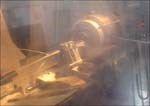In-House Productivity Preserves CAM Investment
This shop launched a major upgrade of many of its manufacturing operations 3 years ago. The facility received ten new CNC machine tools, three multi-spindle turning centers and five mill/turn machines. To achieve the expected return on investment for the biggest machine, new CAD and CAM systems were installed.
John Crane International (JCI), a manufacturer of mechanical sealing for pumps and compressors, has built a machine tool programming system in its Morton Grove, Illinois plant that links the oldest programming method, APT, with the newest in automated and integrated CAM.
As a result, the company’s managers preserved their huge investment in source code (part processing information) and data files (part geometry) that characterized hundreds of thousands of parts. They did this by buying a highly productive CAM system that could not only read APT files but also had tight integration—full interoperability, not just associativity—with solid modeling CAD packages.
In the Morton Grove plant (one of its 22 facilities), JCI launched a major upgrade of many of its manufacturing operations 3 years ago. The facility received ten new CNC machine tools, three multi-spindle turning centers and five mill/turn machines. To achieve the expected return on investment for the biggest machine, new CAD and CAM systems were installed.
EdgeCAM, the company’s new CAM system from Pathtrace Systems Inc. (Southfield, Michigan), came into the picture when JCI’s programmers ran into some APT shortcomings. A product of the 1960s, APT had no effective commands to address turning centers with twin spindles that could do parts hand-offs. The company needed those capabilities because high productivity demanded that parts be machined on all sides with one setup whenever possible.
The company had begun modifying its APT source and data files when management realized how much of a commitment the enhancements involved, not to mention the time and support that would be needed for these enhancements for years to come. Moreover, the old CAM software had no CAD associativity or efficient tools for importing geometry.
JCI’s lead programmer, Terry Goto, implemented the automation with some assistance from the company’s software distributor, Camtech, and Rick Titus, Pathtrace’s Houston-based manager of special projects. EdgeCAM scripting tools called PCIs (process-controlled integration tools) played a key role.
The PCIs alone generated significant savings, according to Mike Eklove, manager of tool engineering for the JCI Seals Division in Morton Grove. "Individual programs that took 15 to 30 minutes each with the old CAM system can now be done in 10 minutes or less with EdgeCAM, with a better graphical representation of the tool path," he says.
Now when an existing part is readied for machining, its CAM files call up as many as four PCIs. In turn, they assemble the drawings, drive the tool paths around the geometry, post process it to specific machine tools and generate the G-code data. PCIs also assemble the data on cutting tools, offsets and fixturing.
Taking advantage of automated programming with PCIs meant converting as many as 300,000 legacy CAM files and ensuring their associativity with 700,000 to 800,000 parts drawings. As of earlier this year, about 250,000 had been converted.
The company now has 621 EdgeCAM PCIs. Because the repetitive decision-making processes of production-volume programming are being automated, the software will eventually have 1,700 to 1,800 PCIs.
"We could not have used the new machine tools effectively without EdgeCAM and without the macros created by Terry Goto," Mr. Eklove explains.
"We would not have been able to use all the APT source-code data, which makes up our processes. And we would have been forced to redraw before we could program, when all we want are the G codes to run the machines."
Related Content
Mastercam Software Improves Programming Flexibility
IMTS 2024: Mastercam introduces Mastercam 2025, with features including Mastercam Deburr for automated edge finishing, finish passes, mill-turn support for Y-axis turning and automatic license update notifications.
Read MoreTech College Alum Returns to Teach CAD/CAM at Alma Mater
New part programming developments continue to be added to the Tri-County Technical College curriculum and solutions for Swiss-type lathes might soon be included.
Read MoreMastercam 2024 Integrates Sandvik Coromant CoroPlus Tool Library
The integrated library enables users to work faster when importing tool geometries and cutting data.
Read MoreHow to Start a Swiss Machining Department From Scratch
When Shamrock Precision needed to cut production time of its bread-and-butter parts in half, it turned to a new type of machine tool and a new CAD/CAM system. Here’s how the company succeeded despite the newness of it all.
Read MoreRead Next
A Tooling Workshop Worth a Visit
Marubeni Citizen-Cincom’s tooling and accessory workshop offers a chance to learn more about ancillary devices that can boost machining efficiency and capability.
Read MoreDo You Have Single Points of Failure?
Plans need to be in place before a catastrophic event occurs.
Read More5 Aspects of PMTS I Appreciate
The three-day edition of the 2025 Precision Machining Technology Show kicks off at the start of April. I’ll be there, and here are some reasons why.
Read More















.jpg;maxWidth=300;quality=90)







